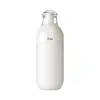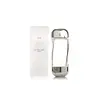What's inside
What's inside
 Key Ingredients
Key Ingredients

 Benefits
Benefits

 Concerns
Concerns

No concerns
 Ingredients Side-by-side
Ingredients Side-by-side

Water
Skin ConditioningGlycerin
HumectantHydrogenated Polydecene
EmollientButylene Glycol
HumectantDipropylene Glycol
HumectantPentaerythrityl Tetraethylhexanoate
EmollientXylitol
HumectantPEG/PPG-17/4 Dimethyl Ether
Skin ConditioningPEG-400
Emulsion StabilisingMaltitol
HumectantTriisostearin
Skin ConditioningPhytosteryl/Octyldodecyl Lauroyl Glutamate
Skin ConditioningAmmonium Acryloyldimethyltaurate/Beheneth-25 Methacrylate Crosspolymer
Emulsion StabilisingErythritol
HumectantXanthan Gum
EmulsifyingDipotassium Glycyrrhizate
HumectantAllantoin
Skin ConditioningRose Extract
Skin ConditioningBarm Extract
Skin ConditioningSodium Acetylated Hyaluronate
HumectantRibes Nigrum Bud Oil
PerfumingArtemisia Vulgaris Extract
Skin ConditioningPinus Pinaster Leaf Extract
Skin ConditioningAcrylates/C10-30 Alkyl Acrylate Crosspolymer
Emulsion StabilisingCarbomer
Emulsion StabilisingSodium Metaphosphate
BufferingPotassium Hydroxide
BufferingSodium Metabisulfite
AntioxidantTocopherol
AntioxidantPhenoxyethanol
PreservativeWater, Glycerin, Hydrogenated Polydecene, Butylene Glycol, Dipropylene Glycol, Pentaerythrityl Tetraethylhexanoate, Xylitol, PEG/PPG-17/4 Dimethyl Ether, PEG-400, Maltitol, Triisostearin, Phytosteryl/Octyldodecyl Lauroyl Glutamate, Ammonium Acryloyldimethyltaurate/Beheneth-25 Methacrylate Crosspolymer, Erythritol, Xanthan Gum, Dipotassium Glycyrrhizate, Allantoin, Rose Extract, Barm Extract, Sodium Acetylated Hyaluronate, Ribes Nigrum Bud Oil, Artemisia Vulgaris Extract, Pinus Pinaster Leaf Extract, Acrylates/C10-30 Alkyl Acrylate Crosspolymer, Carbomer, Sodium Metaphosphate, Potassium Hydroxide, Sodium Metabisulfite, Tocopherol, Phenoxyethanol
Water
Skin ConditioningDipropylene Glycol
HumectantGlycerin
HumectantPEG/PPG-14/7 Dimethyl Ether
Skin ConditioningTranexamic Acid
AstringentPEG/PPG-17/4 Dimethyl Ether
Skin ConditioningSorbitol
HumectantPhenoxyethanol
PreservativeDisodium EDTA
Citric Acid
BufferingDipotassium Glycyrrhizate
HumectantPPG-13-Decyltetradeceth-24
EmulsifyingPolyquaternium-51
Skin ConditioningButylene Glycol
HumectantSodium Citrate
BufferingPotassium Ascorbyl Tocopheryl Phosphate
AntioxidantSodium Metabisulfite
AntioxidantSodium Acetylated Hyaluronate
HumectantPaeonia Albiflora Root Extract
Skin ConditioningRosa Canina Fruit Extract
AstringentOriganum Majorana Leaf Extract
AntiseborrhoeicRubus Suavissimus Leaf Extract
Skin ConditioningTocopherol
AntioxidantBenzoic Acid
MaskingWater, Dipropylene Glycol, Glycerin, PEG/PPG-14/7 Dimethyl Ether, Tranexamic Acid, PEG/PPG-17/4 Dimethyl Ether, Sorbitol, Phenoxyethanol, Disodium EDTA, Citric Acid, Dipotassium Glycyrrhizate, PPG-13-Decyltetradeceth-24, Polyquaternium-51, Butylene Glycol, Sodium Citrate, Potassium Ascorbyl Tocopheryl Phosphate, Sodium Metabisulfite, Sodium Acetylated Hyaluronate, Paeonia Albiflora Root Extract, Rosa Canina Fruit Extract, Origanum Majorana Leaf Extract, Rubus Suavissimus Leaf Extract, Tocopherol, Benzoic Acid
 Reviews
Reviews

Ingredients Explained
These ingredients are found in both products.
Ingredients higher up in an ingredient list are typically present in a larger amount.
Butylene Glycol (or BG) is used within cosmetic products for a few different reasons:
Overall, Butylene Glycol is a safe and well-rounded ingredient that works well with other ingredients.
Though this ingredient works well with most skin types, some people with sensitive skin may experience a reaction such as allergic rashes, closed comedones, or itchiness.
Learn more about Butylene GlycolDipotassium Glycyrrhizate comes from licorice root.
Extracts of licorice have demonstrated to have antibacterial, anti‐inflammatory, antiviral, antioxidant properties.
One component, glabridin, has extra potent antioxidant and soothing properties. It has also been found to block pigmentation from UVB rays in guinea pigs.
Licorice Root also contains a flavonoid. Flavonoids are a natural substance from in plants. Flavonoids also have antioxidant properties.
Another component, glycyrrhizin, has been found to have anti-inflammatory and antimicrobial benefits. This may make licorice root extract effective at treating acne. However, more research is needed to support this.
Liquiritin is one of the flavone compounds found in licorice. It has been found to help lighten skin by preventing tyrosinase from reacting with tyrosine. When the two react, protein is converted to melanin. Melanin is the substance in your body that gives your features pigmentation.
Licorice root is native to Southern Europe and Asia. It has been used in traditional Chinese medicine to help with respiratory issues.
Learn more about Dipotassium GlycyrrhizateDipropylene Glycol is a synthetically created humectant, stabilizer, and solvent.
This ingredient helps:
Dipropylene glycol is technically an alcohol, but it belongs to the glycol family (often considered part of the ‘good’ alcohols). This means it is hydrating and gentle on skin unlike drying solvent alcohols like denatured alcohol.
As a masking agent, Dipropylene Glycol can be used to cover the smell of other ingredients. However, it does not have a scent.
Studies show Dipropylene Glycol is considered safe to use in skincare.
Learn more about Dipropylene GlycolGlycerin is already naturally found in your skin. It helps moisturize and protect your skin.
A study from 2016 found glycerin to be more effective as a humectant than AHAs and hyaluronic acid.
As a humectant, it helps the skin stay hydrated by pulling moisture to your skin. The low molecular weight of glycerin allows it to pull moisture into the deeper layers of your skin.
Hydrated skin improves your skin barrier; Your skin barrier helps protect against irritants and bacteria.
Glycerin has also been found to have antimicrobial and antiviral properties. Due to these properties, glycerin is often used in wound and burn treatments.
In cosmetics, glycerin is usually derived from plants such as soybean or palm. However, it can also be sourced from animals, such as tallow or animal fat.
This ingredient is organic, colorless, odorless, and non-toxic.
Glycerin is the name for this ingredient in American English. British English uses Glycerol/Glycerine.
Learn more about GlycerinWe don't have a description for PEG/PPG-17/4 Dimethyl Ether yet.
Phenoxyethanol is a preservative that has germicide, antimicrobial, and aromatic properties. Studies show that phenoxyethanol can prevent microbial growth. By itself, it has a scent that is similar to that of a rose.
It's often used in formulations along with Caprylyl Glycol to preserve the shelf life of products.
Sodium Acetylated Hyaluronate is a type of Hyaluronic Acid.
Hyaluronic Acids help moisturize, soothe, and protect the skin.
Read about common types of Hyaluronic Acid here:
Sodium Hyaluronate
Hydrolyzed Hyaluronic Acid
Hyaluronic Acid
Sodium metabisulfite is also known as Sodium Pyrosulfite. It is a preservative, antioxidant, and disinfectant.
As a preservative, it helps stabilize cosmetic formulas without affecting their color or scent.
Tocopherol (also known as Vitamin E) is a common antioxidant used to help protect the skin from free-radicals and strengthen the skin barrier. It's also fat soluble - this means our skin is great at absorbing it.
Vitamin E also helps keep your natural skin lipids healthy. Your lipid skin barrier naturally consists of lipids, ceramides, and fatty acids. Vitamin E offers extra protection for your skin’s lipid barrier, keeping your skin healthy and nourished.
Another benefit is a bit of UV protection. Vitamin E helps reduce the damage caused by UVB rays. (It should not replace your sunscreen). Combining it with Vitamin C can decrease sunburned cells and hyperpigmentation after UV exposure.
You might have noticed Vitamin E + C often paired together. This is because it is great at stabilizing Vitamin C. Using the two together helps increase the effectiveness of both ingredients.
There are often claims that Vitamin E can reduce/prevent scarring, but these claims haven't been confirmed by scientific research.
Learn more about TocopherolWater. It's the most common cosmetic ingredient of all. You'll usually see it at the top of ingredient lists, meaning that it makes up the largest part of the product.
So why is it so popular? Water most often acts as a solvent - this means that it helps dissolve other ingredients into the formulation.
You'll also recognize water as that liquid we all need to stay alive. If you see this, drink a glass of water. Stay hydrated!
Learn more about Water